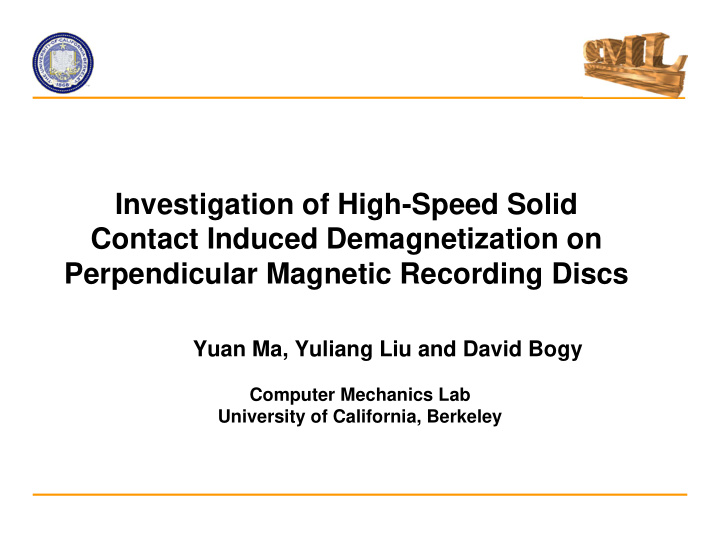



Investigation of High-Speed Solid Contact Induced Demagnetization on Perpendicular Magnetic Recording Discs Yuan Ma, Yuliang Liu and David Bogy Computer Mechanics Lab University of California, Berkeley
Content 1. Introduction 2. Staging details 3. Preliminary results 4. Experiment plan 5. Conclusion
1. Introduction Two main factors to cause demagnetization are stress and temperature. Stress induced demagnetization has been studied in much detail with hysitron Temperature induced demagnetization has been studied with heating plate and laser In HDD, demagnetization and signal loss are sometimes caused by high speed contact between slider and disk, in which process stress and heat are coupled. Aim: To find the weight of the two factors in demagnetization.
2. Staging details Steel probe scratch the rotating disc (5400 RPM) on the vena stage. Ball bearing and lever to control the normal force acting on the probe. Stage movement M drive Ball Bearing Probe Disc N mg f lever f air Rotation Rotation
2. Staging details Probe tip: 15-20 µm in radius Probe tip Probe fixture Applied contact force: 0-500mN Test results showed that the load is sufficiently larger than the air bearing force. Measurement of Measurement of air bearing force static contact force
2. Staging details Contact time control: Within 30ms Driven by the actuator motor, the contact can be controlled within 2 revolutions at 5400 rpm. Contact time controlled by actuator and string
3. Preliminary results OSA scan results to locate the scratch scratch Scribe Scratch on the disc under OSA5100
3. Preliminary results AFM and MFM scan result AFM Particles resulted Change in magnetic MFM from scratch field
3. Preliminary results AFM and MFM scan result Hardly visible scratch on AFM with identifiable magnetic change AFM MFM Visible scratch on AFM with identifiable magnetic change AFM MFM
4. Experiment plan Rewrite magnetization on disks after contact and evaluate the proportion of heat induced demagnetization. Measure the dynamic friction coefficient of the probe-disk interface. Prepare data encoded disk to evaluate the degree of data loss after solid contact. The following questions will be addressed in the experimental studies: How to prepare data encoded disks for the experimental study? How to determine the temperature of the probe tip and contact area under different rotation speeds? How to exclude the recoverable part of stress induced demagnetization?
5 Conclusion A high speed solid contact experimental stage is Completed Contact time and contact load can be adjusted and determined. The Diameter of contact probe is within 20µm. Preliminary tests showed changes in magnetic signal after scratch
Thank you!
Recommend
More recommend